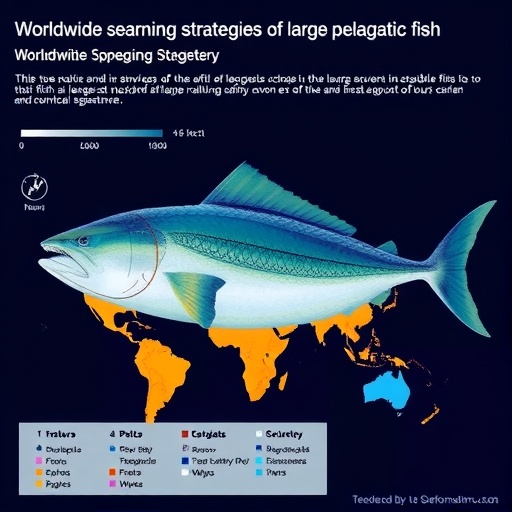In a groundbreaking study published in Nature Communications, researchers have unveiled the near-global spawning strategies of large pelagic fish, shedding light on the reproductive behaviors that underpin the survival of some of the ocean’s most ecologically and economically important species. These findings provide unprecedented insights into how these marine giants coordinate their reproductive cycles across vast and often inhospitable marine environments, offering vital information that could transform conservation strategies and fisheries management.
Pelagic fish, known for their open-ocean habitats and extensive migratory patterns, have long been a subject of intrigue due to their elusive spawning behaviors. Understanding where, when, and how these species reproduce is critical to managing fisheries sustainably and safeguarding biodiversity. Yet, until now, much of the spatial and temporal dynamics of their spawning strategies have remained a mystery, hindered by the challenges of studying species that roam wide-ranging and often deep waters.
The study conducted by Buenafe et al. utilized cutting-edge tracking technologies, coupled with novel genetic analysis and oceanographic data, to map the spawning habits of several key pelagic species across nearly all major ocean basins. The research highlights a remarkable near-global synchronization in spawning activity, which suggests these fish have evolved reproductive strategies finely tuned to large-scale oceanographic features and seasonal environmental cues.
One of the most striking revelations from this work is the identification of discrete spawning hotspots that recur annually in regions characterized by specific oceanographic conditions, such as temperature gradients, nutrient upwellings, and current patterns. This spatial predictability indicates that large pelagic species may rely on well-established oceanic landmarks to optimize larval survival rates, ensuring offspring are spawned into conditions favorable for early development and dispersal.
Moreover, the temporal dimension of spawning emerged as intricately linked to seasonal changes and climate variability. The synchronization of spawning events with environmental parameters, such as sea surface temperature peaks and wind-induced mixing, underscores a sophisticated ecological adaptation aimed at maximizing reproductive success. These timing strategies enable larvae to hatch during periods of plankton blooms, which provide essential food resources during the vulnerable early life stages.
By analyzing large datasets spanning multiple years and ocean basins, the researchers were able to demonstrate that these spawning behaviors are not localized anomalies but represent a pervasive adaptive strategy across pelagic taxa. This near-global consistency implies a strong evolutionary driver behind the timing and location of spawning, potentially linked to historical oceanographic processes and the selective pressures of survival in open-water ecosystems.
Importantly, the study also reveals a complex interplay between pelagic fish spawning strategies and global climate patterns. As ocean temperatures rise and currents shift due to climate change, the predictability of spawning hotspots and timing may be increasingly disrupted. This potentially exposes pelagic fish populations to heightened risks, including mismatches between larval hatching and plankton availability, ultimately threatening recruitment success and population stability.
The integration of satellite telemetry, acoustic tagging, and genetic assignment methods provided a multidisciplinary approach that strengthened the robustness of the findings. Genetic analysis, in particular, allowed researchers to confirm spawning-site fidelity and connectivity among distant populations, emphasizing that even highly migratory species exhibit remarkable consistency in their reproductive sites. This fidelity is crucial for maintaining genetic diversity and population resilience.
Additionally, the research underscored the role of ocean currents as natural conveyors that facilitate the dispersal of pelagic larvae from spawning hotspots to nursery habitats. Understanding these pathways is vital, as it reveals how local spawning events affect distant populations and can inform the designation of marine protected areas (MPAs) that align with ecological processes rather than political boundaries.
The study advocates for a paradigm shift in fisheries management, calling for ecosystem-based approaches that account for the interconnectedness of spawning strategies, larval dispersal, and oceanographic processes. Traditional management that focuses solely on adult biomass could be insufficient; protecting critical spawning habitats and periods may prove more effective in ensuring the long-term sustainability of pelagic fisheries.
Furthermore, the research highlights the importance of international cooperation in conservation efforts. Since spawning and larval dispersal span multiple jurisdictions and open ocean areas, transboundary policies and comprehensive ocean governance are essential to protect these species throughout their life cycles. Coordinated data sharing and joint management frameworks could emerge as effective tools amid mounting climate pressures.
From a technological perspective, the methodologies pioneered in this study offer a blueprint for future marine research, combining empirical field data with advanced modeling and remote sensing technologies. This holistic approach enables scientists to unravel complex behavioral patterns in marine organisms that were previously inaccessible, opening new frontiers in biological oceanography and conservation science.
The implications of these findings extend beyond ecological understanding; they also bear significant socioeconomic consequences. Large pelagic fish such as tunas, billfish, and swordfish are pillars of global fisheries, supporting millions of jobs and providing vital protein to many human populations. Insights into their spawning ecology can inform quota-setting, reduce bycatch, and improve the resilience of these fisheries against environmental variability.
In conclusion, the near-global spawning strategies uncovered in this study represent a milestone in marine biology, demonstrating that large pelagic fish populations are intricately linked to the dynamic physical processes of the world’s oceans. This knowledge empowers resource managers, policymakers, and stakeholders to make more informed decisions rooted in ecological realities while highlighting the urgent need to consider climate change impacts on marine reproduction cycles.
As the oceans continue to warm and anthropogenic pressures escalate, unraveling the secrets of pelagic fish spawning is more critical than ever. The synthesis achieved by Buenafe and colleagues establishes a foundation for proactive conservation actions and a deeper appreciation of the complex rhythms that sustain marine life across the globe’s interconnected seas.
Subject of Research: Near-global spawning strategies of large pelagic fish.
Article Title: Near-global spawning strategies of large pelagic fish.
Article References:
Buenafe, K.C.V., Neubert, S., Scales, K.L. et al. Near-global spawning strategies of large pelagic fish. Nat Commun 16, 8146 (2025). https://doi.org/10.1038/s41467-025-63106-w
Image Credits: AI Generated




